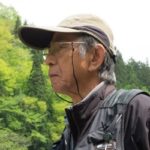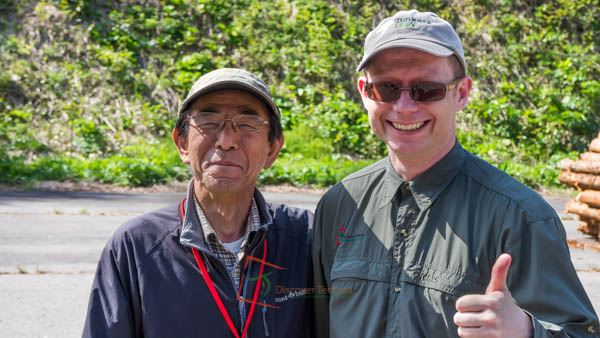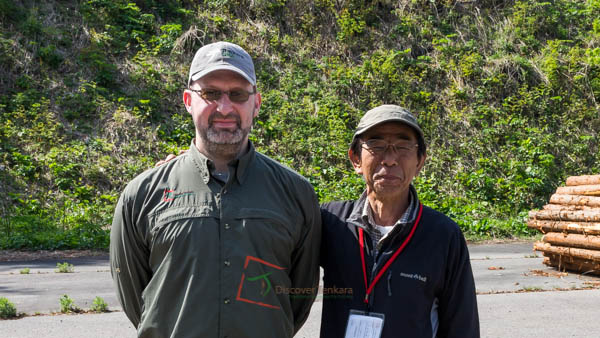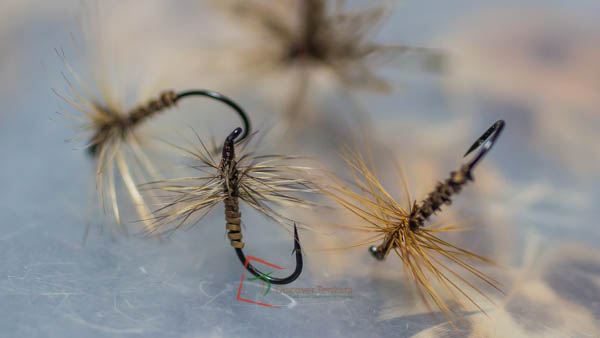
Meeting a Living Legend: Masami Sakakibara AKA Tenkara no Oni
Masami Sakakibara (Tenkara no Oni or the Demon/Ogre of Tenkara!) is one of the best-known and most skillful tenkara anglers and casters in Japan. To get you primed up, here’s one of his iconic and super-effective patterns via a great demo from JP:
Before we get too deeply into the subject of “Oni Tenkara” – quite a cast of people were crucial to our first fishing research trip to Japan which – fundamentally – came about following Dr. Ishigaki’s kind invitation to visit (and subsequent organisation of our schedule) after we hosted him in England in summer 2013. We are eternally grateful for all the help, hospitality, generosity and lessons that everyone we met in Japan extended to us. Thank you all. We will be giving lots more accounts of our meetings with a whole range of people and our experiences (both on and off the river!) in our upcoming blog posts…Further down this post, I’ll highlight some of the factors that make “Oni” tenkara special.
Selfies with Tenkara no Oni 🙂

This post, though, is dedicated to the short two days we spent with famous casting maestro and genius tenkara technician Masami Sakakibara. If we were to summarise this experience, we would say that “two days is not long enough” due to the depth and subtlety of Masami’s skills and knowledge. Six months to a couple of years would probably be a more realistic introductory study period…

Now, lots of you are probably thinking that this all sounds a bit over the top and – perhaps – a bit of an exaggeration. This healthy scepticism is a good thing and, apart from anything else, gives me a good excuse to try to break down just exactly how and why Masami is so good. It is worth making it clear from the outset that there is nothing “mystical” about Masami’s skills – he just has a lot of natural talent and has coupled that with diligent practice over many years. Similarly, his great skill does not mean that he goes out and catches hundreds of fish every single time out – irrespective of conditions. However, on hard days when most people will catch nothing, he will usually catch a few – or maybe even “several”! In conditions where the fish are feeding well, he will catch many more…
Where did Oni get his Nickname?
The inside story on how “Tenkara-no-Oni” became Masami’s Tenkara nickname seems to be that, in his younger years, he was always extremely severe in his facial expression (and personality). Over time he has become much more relaxed – but the incredible focus when he is fishing has never left him. This is probably the reason that his old nickname of the “Demon/Ogre” of tenkara stuck.
Unweighted kebari

It is also definitely worth highlighting that Masami’s passion is in developing his presentation skills by using only wet flies (kebari) that are constructed along broadly similar principles to traditional Japanese tenkara patterns. In other words, he doesn’t have any desire to use specially weighted flies (e.g. via the addition of tungsten beads, split shot or lead wire/extra heavy gauge wire hooks etc.). Masami’s passion is to make his tenkara a game of beautiful casting and reading stream currents, wind, fish behaviour (and more) in order to either draw a fish up to an unweighted kebari – or to ride the currents to sink his kebari to a deeper-lying fish.
As we will see in subsequent blog posts, there are other members of the Japanese tenkara community who adopt non-traditional fly designs in different circumstances (including the use of presentation tactics that incorporate weighted flies). Whilst we, ourselves, are deeply interested in the skillset associated with fishing unweighted flies – we do (on occasions such as cold weather or an especially deep/powerful river) try fishing bead head kebari. It is important to recognise that Masami’s choice of sticking to unweighted flies really forces the angler to acknowledge and understand the stream environment in order to get fish to see the fly (and it is this approach that we usually adopt and certainly enjoy the most). It is a very pure game of specific skills and aesthetics. Oh, and did we mention he catches a lot of fish. An awful lot of fish. On rivers/days that many other people struggle to match that catch rate whilst using a whole range of kit that should give them the advantage…
Tenkara no Oni: What Separates him from the rest?
So what are some of the factors that contribute to that edge in performance? Well, acknowledging that the time spent with him was too short to produce anything like a definitive answer – we can at least identify several examples in the categories below:
Masami’s Detailed understanding of currents
Masami sometimes demonstrates to students how river currents work by dropping leaves into the water and watching their progress around eddies. From this, it is very evident that such eddies occur at all angles to the surface – including those currents that sweep food items towards the stream bed and/or towards the water’s surface. We spent a long conversation on the subject of current flows that covered areas that I, normally, only get to discuss during my river restoration work with professional “geomorphologists” involved in modelling river channel dynamics. So, without recourse to the professional’s equations, Masami has developed a very strong understanding of how river currents work purely from his own observations. In fact, his knowledge of how these features are arranged spatially is also complemented by the understanding that these currents vary in time as well as space. In other words, sometimes the angler must wait for the right “bloom” of a particular current eddy in order to take advantage of it (perhaps to hold the fly in place for a few moments longer in a slow rotation of current in the middle of much faster torrents that would pull the fly away before a fish felt confident to grab it).
Oni’s Integrated knowledge of fish behaviour
By “integrated” I mean that Masami not only knows how to read the stream to find fish; but he also knows how their response to the fly or their ability to detect or tolerate the angler’s presence will change under different weather and stream conditions. As a few examples of this, as well as understanding the water currents (as discussed above) – he will use this to deduce the perfect spots for fish to lie in wait for food (as most good anglers do). However, the difference in the degree of detail is important here. A great illustration is the way that, by understanding the rotation (in vertical as well as horizontal planes) of turbulent water; Masami can sometimes identify spots where fish will be lying with their heads pointing at a downward angle towards the river bed. They are finding the most energetically efficient angle to lie and to spot concentrations of prey. From this he knows that a.) He can afford to approach them a little more closely than fish sitting more level with the water surface and b.) He will need to get his fly sucked down deep enough into that turbulent current before the fish will be able to see it and want to take it.
A more simple illustration (that many more anglers will be familiar with) is the increase in turbulence that occurs during runoff from rainfall which disguises the angler’s presence much more than low flows in bright conditions.
The “Tenkara-no-Oni” Positional Sense
Over many years of trial and error (and using the integrated fish behaviour knowledge mentioned above) Masami is able to look at a section of river and understand right away the sequence of spots that he will need to stand as he works through the pool covering fish. From each spot it is possible to make the best cast and associated presentation to each of the likely fish-holding lies. More importantly, for the specific conditions on each day, standing in each perfect spot (sometimes crouching if appropriate) will allow the angler to cast without spooking the fish. This will vary according to the target species of fish. However, in keiryu tenkara (smaller stream tenkara) for all species this will almost always involve a “fly only” cast – where none of the casting line is allowed to disturb the water and potentially scare the fish. These “perfect positions” will change according to conditions that affect either the angler’s ability to present the fly (e.g. wind) or the spookiness of the fish (e.g. water level and sunlight conditions). You can sense Masami wincing a little bit on the inside when an angler or pupil chooses a stance or approach that is outside the instantly identified “best” sequence of positions! He is very kind though and offers advice with a smile and a laugh!! It is also this positional sense that allows the fly to be paused in likely spots by using a combination of eddying water currents, angle of cast and wind strength/direction.
Oni’s Pace of coverage
As well as knowing where to cast to (and where to cast from!), Masami has a great feel for when to give up on a spot and when to keep trying. This, again, will vary according to a lot of considerations. An obvious factor is whether the water has lots of fish and also experiences catch and release fishing (versus areas that fish density is lower due to catch and kill fishing by bait anglers). Wasting time on making a perfect presentation (repeatedly and with a suite of variations!) to a beautiful spot that has no fish is time that could be better spent finding a spot where a fish is actually present! By contrast, fish that have seen a lot of artificial flies tend to have a more refined definition of size and “action” that signals something that is worth eating. Giving up before cracking the presentation code on each of these fish will mean that you are unlikely to catch very much.
Of course, there are so many more things (including the wonderfully elegant and efficient casting stroke that is so accurate) that make Masami an exceptionally effective and gifted river angler. His poise, focus and movement around the stream are surprisingly similar to top European competition anglers and I suspect he would do really quite well in that environment (except that he isn’t interested in competition or in styles of fishing that sometimes incorporate weighted flies!!).
Is he some kind of mystic being with magical powers? No. Instead he is extremely technically gifted, well-practiced and deeply knowledgeable and, to me, that is actually more impressive! He is also a really nice guy who surprised both of us with a big bear-hug (not a typical Japanese custom!) when he had to leave us and let us continue with the rest of our trip!!
Thank you to both Masami and Kyoko for your hospitality, company (all that wonderful food that you shared with us – Kyoko’s sansai tempura is wonderful) and generous teaching. It was a fantastic experience and we hope that we can begin to repay the debt in future. Big thanks also to Satoshi Miwa for wonderful translations (and very kind consideration for our feelings by finding a good thing to praise before offering any small points of correction!!!).
Look out for future video content from this trip on both Discover Tenkara and Oni websites…
Paul
